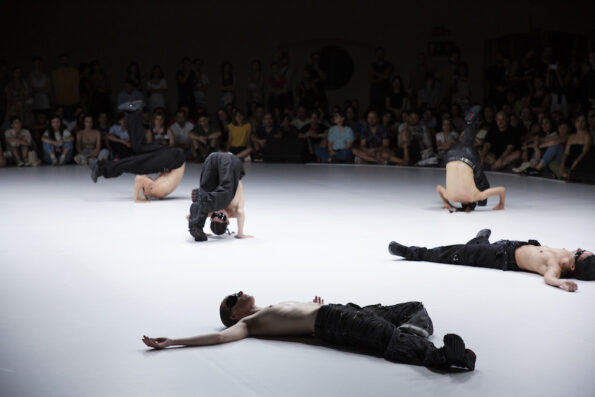Search
To search for an exact match, type the word or phrase you want in quotation marks.
A*DESK has been offering since 2002 contents about criticism and contemporary art. A*DESK has become consolidated thanks to all those who have believed in the project, all those who have followed us, debating, participating and collaborating. Many people have collaborated with A*DESK, and continue to do so. Their efforts, knowledge and belief in the project are what make it grow internationally. At A*DESK we have also generated work for over one hundred professionals in culture, from small collaborations with reviews and classes, to more prolonged and intense collaborations.
At A*DESK we believe in the need for free and universal access to culture and knowledge. We want to carry on being independent, remaining open to more ideas and opinions. If you believe in A*DESK, we need your backing to be able to continue. You can now participate in the project by supporting it. You can choose how much you want to contribute to the project.
You can decide how much you want to bring to the project.

I’m on Instagram and I see that Joan Morey, a performance artist, has announced an event by Candela Capitán, MOLOKO VELLOCET, to be held within the framework of the Grec Festival in Barcelona. In two days I’ll be returning to Barcelona after a nine-month stay in Madrid, and that seems like the perfect plan to start the summer holidays.
Since I met Joan, about a year and a half ago, I’ve always wanted to attend a live performance. This is not the first collaboration with Candela Capitán, whose work that I learned about through contact with Joan’s work, as can be seen in LA INFLUYENTE. Una performance expandida para pantallas y cuerpos (The Influencer, an Expanded Performance for Screens and Bodies) (2019), in which Candela played the role of T€R€$A, created by Joan, and presented at the Centro Botín. Seeing this combination of artists, and the rave atmosphere that was evoked in the Instagram posts that promoted the work, it was clear that I would not leave disappointed.
I arrived in Barcelona a day ago and I am now heading to the Sala Oval at the MNAC to attend what will be the third activation of MOLOKO VELLOCET, entitled The Death at The Club [in 45 min. female], with a DJ set by TOCCORORO. This is the last of three events that have taken place over the past week (July 7, 11 and 13). In the first event, the performers were all men, and in the second Cadela Capitán performed a solo. The show I saw was with all women. I’ve read that the performance was inspired by the novel A Clockwork Orange (1962), by Anthony Burgess, adapted to film by Stanley Kubrick in 1971, one of my favorite films (as much as that might sound like a cliché). From the very beginning, I saw the connection: the construction of a dystopian scenario, the repeated actions throughout the entire performance, the attention of the audience to this repeated action, the “rave” costumes, the musical background of a snippet from Beethoven’s Ninth Symphony that plays as people enter the room. All these things transport me to the film, and in particular to the scene where Alex, the protagonist of the film, is subjected to the Ludovico treatment, forced to visualize a series of violent images under the effects of drugs designed to reform him. Even so, what Candela Capitán proposes in this dystopian universe seems to me to cause the opposite effect: we are subjected to a Ludovico method that awakens free will in us, giving us a certain position vis-a-vis the system that allows us to question it.
So, after waiting in line for a while, the public began to enter the Oval Room of the MNAC, where five performers awaited us in a completely rigid position, as if they were sculptures. After fifteen minutes in which the public seated themselves around the central space to the accompaniment of Beethoven’s classical music, the music began to transform into hard techno. At this moment, first one performer and then another begin to do the following action repeatedly and completely synchronized with each other: a somersault forward, three steps back. Each of the five performers begin to adapt to the movement, creating a choreography driven by complete synchrony. The action continues to develop until, after fifteen minutes, one of them falls to the ground. A few minutes later, another falls. Soon after, one of the fallen performers is revived. One falls down while another gets up. We are witnessing a game of constant death and reanimation, to remind us of the rhythms of life imposed by contemporary times, the same daily cycle we live when we get up, go to work, rest and return to the same action the next day.
The robot-like movement at the beginning of the performance, with the passage of time and fatigue, becomes more and more humanized. The performer in the center, has not stopped since the beginning of the action, almost forty minutes ago, and now has large red marks on her back and is breathing rapidly. When performing somersaults, I notice she loses her balance slightly, surely a victim of dizziness caused by continuous action and the flow of blood to the head. This becomes more evident when the music briefly relaxes and I can hear their backs hit the ground. Their endurance seems even more spectacular to me. In the last fifteen minutes, there are two moments that create a beautiful choreography: one in which the performer in the center, falls and the other performers continue with the action, and another in which they all fall and only one continues with the action. It is at this last moment, after forty-five or fifty minutes have passed since the beginning of the action, when one begins to sense the end is coming, and the volume of the music decreases. When the music stops, this last performer continues with the action, does a few more somersaults, and we can clearly hear both the smack of their back against the ground and their accelerated breathing. At the end they stop and remain standing while the others lie on the ground.
It is at this moment that the audience begins to applaud. After several minutes, the applause wanes and the audience wonders whether to leave the room or not. A beautiful image remains on the stage, the contrast of a performer standing tall and the others who have fallen in combat, one might say. I decide to stay a few more minutes in the room, as if I were waiting for something, like when we remain in the cinema to see if there will be a final scene after the credits. In the end, I leave after saying goodbye to both Joan Morey and Daniel Cao, in charge of photography and overseeing the entire project. I leave the Oval Room of the MNAC behind, admiring the great still-life drawn by the bodies center stage. It is a farewell that drags on and that, in reality, reminds me quite a bit of what I have experienced at various techno parties I have gone to, that moment when your ears are ringing and you are recovering from all the action and dancing for hours. In this case, though, the hardest thing has been to remain seated while moved by the rhythm of the hard techno that accompanies the action at all times. As the title suggests, it is at this moment that we witness and experience death in the club, which is actually nothing more than the culmination of this game of death and reanimation that is experienced at these kinds of parties over the course of hours, inspired by various substances and music that takes you from one extreme to another. In the end, it is a metaphor for our own daily lives, but at the same time it is also a space that, for a few hours, challenges the status quo in every way.
[Featured Image: The Death at the Club [en 45min. female]. DJ set by TOCCORORO. Photography: Daniel Cao]

Gerard Zamora (Sant Cugat del Vallés, 2001) holds a degree in Art History with a mention in Artistic Heritage Management (UAB), and a master’s degree in Contemporary Art History and Visual Culture (UAM, UCM, MNCARS). His research has been based on the exploration of the contemporary artistic fabric of Barcelona and Madrid. He has also participated as curator in exhibitions such as “Entre lo íntimo y lo exterior” (Galería Nueva) and “Sobre la mesa: Semióticas de la cocina” (Biblioteca MNCARS); and collaborates in publications such as A*Desk Critical Thinking.
"A desk is a dangerous place from which to watch the world" (John Le Carré)